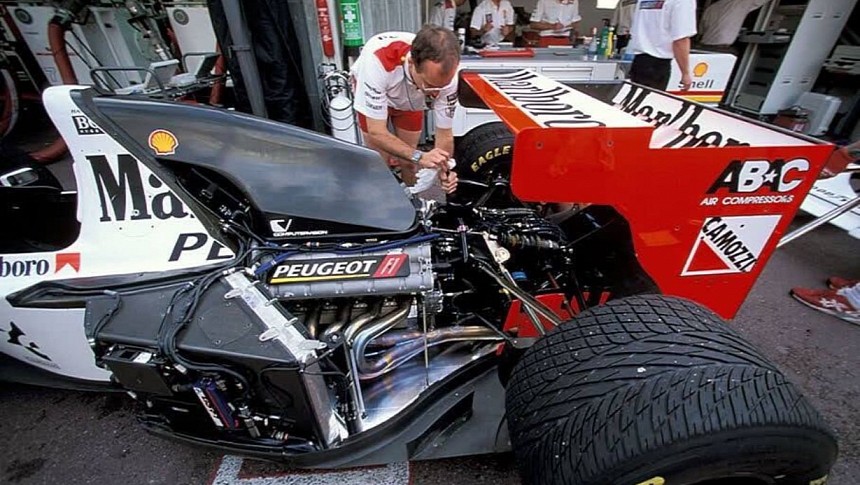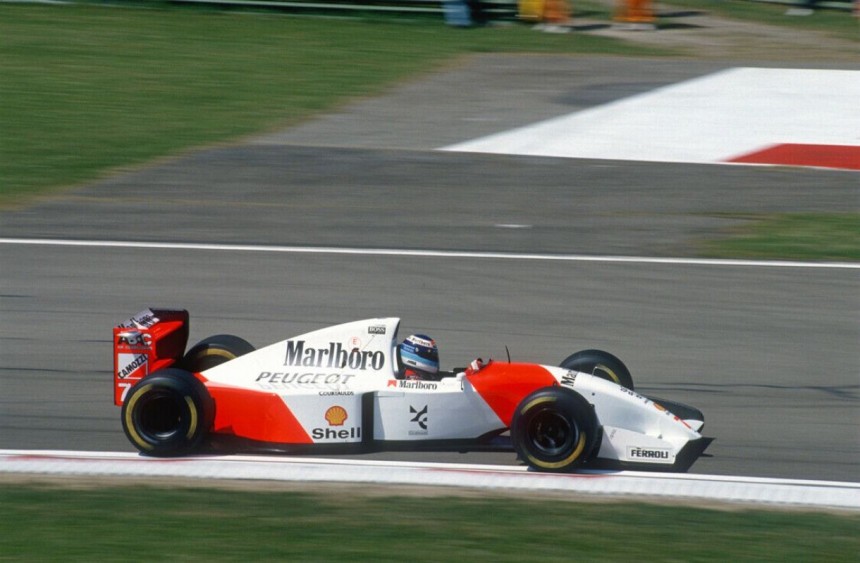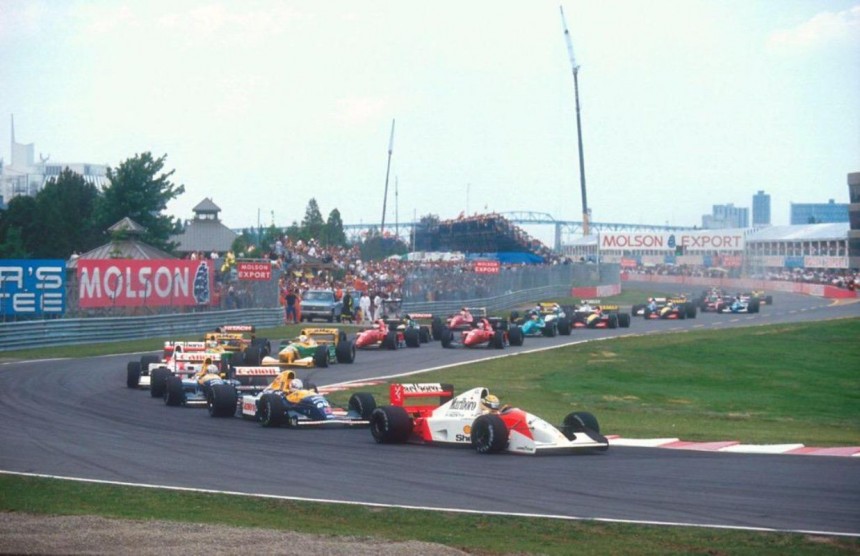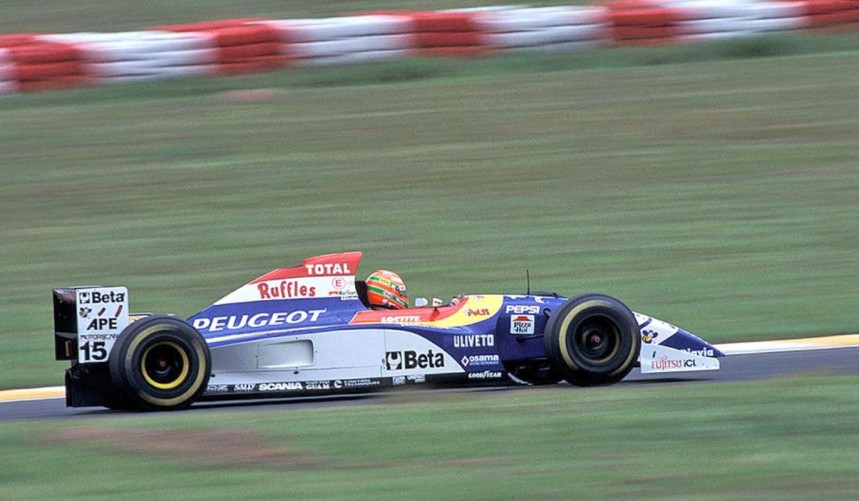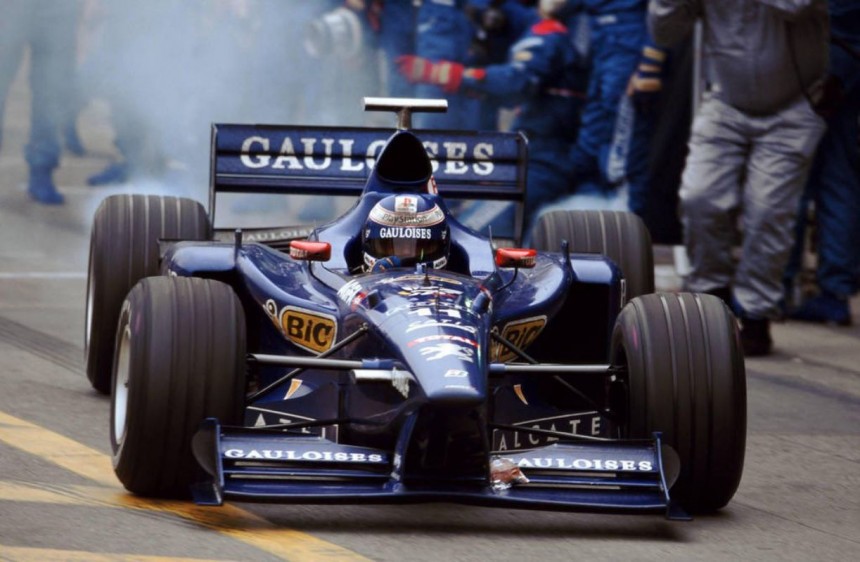The power units propelling today's racing beasts are intricate masterpieces of engineering, tailor-made for performance. The development of such marvels incurs hefty costs, often running into tens of millions and substantial financial backing from the manufacturer. Consequently, only three powerhouses - Ferrari, Mercedes, and Renault - took on the formidable challenge of developing power units for the hybrid era's onset in 2014. Honda made its entry onto the grid a year later, before departing in 2021, with their engines now donning the label of Red Bull Powertrains (RBPT).
Rewinding to the 1990s, the landscape was strikingly dissimilar. V10s and V8 engines, though pricey, were less complex to develop according to the standards of the day. When a team today opts for a power unit swap, it's usually announced years in advance, allowing ample time for the manufacturer and the team to synergize their design efforts. Conversely, in the 1990s, an engine change could be proclaimed in the latter part of a season and implemented in the next, sometimes within a span of mere six months. Much like our Worst Teams series, the engine could determine your grid destiny.
During the 1990s, Renault, Mercedes, Honda, and Ferrari produced the cream of the engine crop, with McLaren and Williams snagging all titles from 1990 to 1997. Honda bowed out at the end of 1992, paving the way for Mercedes and Ferrari to vie for the best-engine title after Renault's 1997 exit. Other manufacturers dabbled in V10 or V8 engine development, reaping varying degrees of success. This list reminisces the lost names of the sport, some glorious, others less so.
Peugeot serves as a poignant reminder of the twisted dance between potential and reality. At one point, this French maker boasted one of the grid's fastest engines. Yet, its F1 legacy is marred by disappointment, without any victories or championships to its name. Having started the millennium with a flicker of promise, Peugeot eventually faded into the backdrop of forgetfulness, its potential unfulfilled.
The narrative of Peugeot could have taken a drastically different turn if Jean Todt, the architect of Ferrari's reign from 1999 to 2004, had not been lured away. As the Director of Peugeot (Talbot) Sport between 1982 and 1993, Todt was instrumental in reshaping Peugeot's Motorsport presence, bringing them notable successes.
However, Ferrari President Luca di Montezemolo successfully courted him in 1994. Todt's subsequent transformation of Ferrari from 1994 to 1996 has entered racing lore, and by the dawn of the 2000s, the Scuderia stood unchallenged. The 'what-ifs' of Todt remaining with Peugeot and steering its F1 journey will forever remain in the realm of conjecture. Nevertheless, it's reasonable to speculate that Peugeot might have been graced with more gleaming trophies had Todt stayed at the helm.
In 1992, Honda exited the F1 stage, leaving behind a glorious legacy of 69 race triumphs, 5 Constructor's Championships, and 5 Driver's titles. The 1988 MP4/4, a magnum opus of McLaren and Honda, clinched 15 out of 16 races. With a Ford deal in place for 1993 and Senna famously contracted on a race-by-race basis, Team Principal Ron Dennis explored multiple avenues before finally selecting Peugeot for a works deal in 1994. His vision was for Peugeot and Renault to engage in a fierce technological duel, vying for dominance.
Off-track skirmishes between McLaren and Peugeot kicked off swiftly. Peugeot advocated for a French driver to accompany new recruit Mika Hakkinen. With Alain Prost retired yet contract-bound at Williams and disinclined to compete against new hire Ayrton Senna, Phillipe Alliot was the target. Dennis was opposed to this proposition, eventually securing his choice, Martin Brundle, for the position. While Alliot wasn't entirely ruled out, he was appointed as the Test and Reserve driver. Hakkinen put the new MP4/9 through its paces pre-season, with the contractual melodrama not resolving until the eve of the season.
The Peugeot A4 V10 lifted directly from the victorious 905 Le Man's car, stirred high expectations. However, the season's first race served as a harsh reality check for both McLaren and Peugeot. With P8 and P18 qualifying positions, the A4 was noticeably off the pace set by the leading Renault V10 and Fordwww.autoevolution.com/ford/ V8. Reliability plagued the A4 V10, culminating in both McLarens bowing out in the initial two rounds. In the first nine races, Hakkinen finished merely twice, despite landing on the podium both times. While not all exits resulted from engine failures - driver errors shared the blame - Martin Brundle, too, managed to complete just three out of the first nine races, with his engine dramatically failing at the British Grand Prix at the green light. Phillipe Alliot, the reserve driver, fared no better, retiring during his sole season appearance in Hungary after Hakkinen received a one-race ban for triggering a colossal start line pileup in the preceding German race.
Although the pace showed signs of improvement from the tenth round, Ron Dennis harbored deep reservations about Peugeot's dedication to its F1 endeavor. The once-respected McLaren was now a mid-field fixture, and any sight of a yellow flag could indicate yet another Peugeot engine failure. A series of three consecutive podiums by Hakkinen towards the season's end couldn't mend the strained relationship, leading Ron Dennis to ink a long-term contract with Mercedes for 1995.
Eddie Jordan promptly seized the opportunity to employ Peugeot as the engine manufacturer for his team in 1995. Despite being only in its fourth season, Jordan had made a mark by clinching P5 in the 1994 Constructor's championship, credit due to a significantly upgraded Hart engine. Although McLaren's dramatic failures were still fresh in memory, Eddie Jordan perceived the prospect of aligning with a major engine producer as an unparalleled chance. This contrasted starkly with Hart's comparably diminutive operation. The arrangement also benefitted Peugeot, allowing them to enhance their reliability away from glaring scrutiny. Partnering with Jordan offered a respite from intense pressure, strikingly analogous to Honda's switch to AlphaTauri from McLaren in 2018.
The year 1995 was yet another letdown for Peugeot. Even though reliability saw a gradual uptick, a spate of crashes and engine breakdowns resulted in a mere 21 points by year-end. Jordan ended up at P6 in the Constructor's tally. The season's highlight was the Canadian Grand Prix, with Rubens Barrichello and Eddie Irvine securing the second and third spots in a highly attrition-ridden race. Despite these advancements, reliability continued to be a thorn in Peugeot's side, with 1995 witnessing four double retirements and only four races in which both cars reached the finish line. Unfazed, Eddie Jordan carried on with Peugeot into 1996.
With 1996 ushering in all-new technical regulations for F1, cars underwent substantial alterations, and overall downforce was curtailed. This change came in response to the heart-rending demise of Ayrton Senna two years prior. Optimism surged for Jordan and Peugeot in 1996 following a tough inaugural season. Martin Brundle joined the team, reuniting with Peugeot after their unsuccessful stint at McLaren in 1994. He had a long history with Jordan, having raced for him in lower tiers during his early racing career.
The young yet speedy Rubens Barrichello remained with the team. The season kicked off with a double retirement, but not attributable to Peugeot. Martin Brundle experienced a hair-raising crash into turn three, his Jordan flipping at high velocity. Remarkably, Brundle emerged unscathed. Improved reliability and consistency nudged Jordan up to P5 in the Constructor's championship. However, 1996 didn't offer any podiums, and the 196 car was dismissively referred to as "a dog" by Martin Brundle.
The year 1997 could've been the golden era for Peugeot, marking its ascendance to a front-running powerhouse. Towards the season's end, the A14 V10 emerged as potentially one of the fastest engines on the grid. Yet, consistency and reliability remained elusive for Jordan and Peugeot. New recruits Giancarlo Fisichella and Ralf Schumacher suffered due to engine failures and driver mishaps. With a P5 finish again, multiple podiums, and the highly coveted first victory for Eddie Jordan remained out of grasp. Despite notching three podiums and 11 points-scoring finishes, Eddie Jordan was in the hunt for a new engine partner for 1998. The determined Irishman signed a deal with Mugen Honda.
External political factors steered Peugeot into forging a partnership with Alain Prost's team in 1998. On the brink of the 1997 season, Prost had acquired the Liger outfit, which was performing remarkably well. Although devoid of wins, Oliver Panis twice graced the podium in the Mugen Honda-powered vehicle. Prost clinched P6 in the Constructor's Championship, just a step behind Jordan. The inception of the Prost-Peugeot collaboration in 1998 had the lofty ambition of transforming the all-French ensemble into a dominant force.
However, the partnership spiraled into an unmitigated catastrophe. Not only did the reliability issues intensify, but the Prost AP01 also lagged deplorably in speed. Jarno Trulli's crashes further dampened their prospects, culminating in a P9 finish in the Constructor's standings with a mere single point. By the season's end, the once-illustrious image of Prost Peugeot contending with giants like McLaren and Ferrari had faded into oblivion, with their cars getting lapped in every race.
The year 1999 saw a modest uptick, with the team securing P7. With John Barnard stepping in as Technical Director, the car demonstrated some speed in qualifying sessions, only to vanish. Jarno Trulli's P2 finish at the chaotic Luxemburg Grand Prix at Nurburgring and Panis's P6 at the German Grand Prix were the lone instances of Prost scoring points that year. The 2000 season marked the nadir for both Peugeot and Prost, with the team ending up at the bottom of the Constructor's Championship, devoid of any points. Even though they sacked the car's designer early on, Prost and Peugeot had no path to redemption. The manufacturer withdrew at year-end, transferring the IP to Asiatech, who managed the engines for a couple of seasons for tail-end teams.
So, where did Peugeot stumble? In a nutshell, the company failed to evolve its approach. F1, being a ruthless sport that devours capital, can't be conquered by merely throwing money at problems. It demands considerable investment in innovation, something Peugeot neglected. They exited F1 with an unfortunate record of 115 race starts and not a single win.
During the 1990s, Renault, Mercedes, Honda, and Ferrari produced the cream of the engine crop, with McLaren and Williams snagging all titles from 1990 to 1997. Honda bowed out at the end of 1992, paving the way for Mercedes and Ferrari to vie for the best-engine title after Renault's 1997 exit. Other manufacturers dabbled in V10 or V8 engine development, reaping varying degrees of success. This list reminisces the lost names of the sport, some glorious, others less so.
Peugeot serves as a poignant reminder of the twisted dance between potential and reality. At one point, this French maker boasted one of the grid's fastest engines. Yet, its F1 legacy is marred by disappointment, without any victories or championships to its name. Having started the millennium with a flicker of promise, Peugeot eventually faded into the backdrop of forgetfulness, its potential unfulfilled.
The narrative of Peugeot could have taken a drastically different turn if Jean Todt, the architect of Ferrari's reign from 1999 to 2004, had not been lured away. As the Director of Peugeot (Talbot) Sport between 1982 and 1993, Todt was instrumental in reshaping Peugeot's Motorsport presence, bringing them notable successes.
In 1992, Honda exited the F1 stage, leaving behind a glorious legacy of 69 race triumphs, 5 Constructor's Championships, and 5 Driver's titles. The 1988 MP4/4, a magnum opus of McLaren and Honda, clinched 15 out of 16 races. With a Ford deal in place for 1993 and Senna famously contracted on a race-by-race basis, Team Principal Ron Dennis explored multiple avenues before finally selecting Peugeot for a works deal in 1994. His vision was for Peugeot and Renault to engage in a fierce technological duel, vying for dominance.
Off-track skirmishes between McLaren and Peugeot kicked off swiftly. Peugeot advocated for a French driver to accompany new recruit Mika Hakkinen. With Alain Prost retired yet contract-bound at Williams and disinclined to compete against new hire Ayrton Senna, Phillipe Alliot was the target. Dennis was opposed to this proposition, eventually securing his choice, Martin Brundle, for the position. While Alliot wasn't entirely ruled out, he was appointed as the Test and Reserve driver. Hakkinen put the new MP4/9 through its paces pre-season, with the contractual melodrama not resolving until the eve of the season.
The Peugeot A4 V10 lifted directly from the victorious 905 Le Man's car, stirred high expectations. However, the season's first race served as a harsh reality check for both McLaren and Peugeot. With P8 and P18 qualifying positions, the A4 was noticeably off the pace set by the leading Renault V10 and Fordwww.autoevolution.com/ford/ V8. Reliability plagued the A4 V10, culminating in both McLarens bowing out in the initial two rounds. In the first nine races, Hakkinen finished merely twice, despite landing on the podium both times. While not all exits resulted from engine failures - driver errors shared the blame - Martin Brundle, too, managed to complete just three out of the first nine races, with his engine dramatically failing at the British Grand Prix at the green light. Phillipe Alliot, the reserve driver, fared no better, retiring during his sole season appearance in Hungary after Hakkinen received a one-race ban for triggering a colossal start line pileup in the preceding German race.
Eddie Jordan promptly seized the opportunity to employ Peugeot as the engine manufacturer for his team in 1995. Despite being only in its fourth season, Jordan had made a mark by clinching P5 in the 1994 Constructor's championship, credit due to a significantly upgraded Hart engine. Although McLaren's dramatic failures were still fresh in memory, Eddie Jordan perceived the prospect of aligning with a major engine producer as an unparalleled chance. This contrasted starkly with Hart's comparably diminutive operation. The arrangement also benefitted Peugeot, allowing them to enhance their reliability away from glaring scrutiny. Partnering with Jordan offered a respite from intense pressure, strikingly analogous to Honda's switch to AlphaTauri from McLaren in 2018.
The year 1995 was yet another letdown for Peugeot. Even though reliability saw a gradual uptick, a spate of crashes and engine breakdowns resulted in a mere 21 points by year-end. Jordan ended up at P6 in the Constructor's tally. The season's highlight was the Canadian Grand Prix, with Rubens Barrichello and Eddie Irvine securing the second and third spots in a highly attrition-ridden race. Despite these advancements, reliability continued to be a thorn in Peugeot's side, with 1995 witnessing four double retirements and only four races in which both cars reached the finish line. Unfazed, Eddie Jordan carried on with Peugeot into 1996.
With 1996 ushering in all-new technical regulations for F1, cars underwent substantial alterations, and overall downforce was curtailed. This change came in response to the heart-rending demise of Ayrton Senna two years prior. Optimism surged for Jordan and Peugeot in 1996 following a tough inaugural season. Martin Brundle joined the team, reuniting with Peugeot after their unsuccessful stint at McLaren in 1994. He had a long history with Jordan, having raced for him in lower tiers during his early racing career.
The year 1997 could've been the golden era for Peugeot, marking its ascendance to a front-running powerhouse. Towards the season's end, the A14 V10 emerged as potentially one of the fastest engines on the grid. Yet, consistency and reliability remained elusive for Jordan and Peugeot. New recruits Giancarlo Fisichella and Ralf Schumacher suffered due to engine failures and driver mishaps. With a P5 finish again, multiple podiums, and the highly coveted first victory for Eddie Jordan remained out of grasp. Despite notching three podiums and 11 points-scoring finishes, Eddie Jordan was in the hunt for a new engine partner for 1998. The determined Irishman signed a deal with Mugen Honda.
External political factors steered Peugeot into forging a partnership with Alain Prost's team in 1998. On the brink of the 1997 season, Prost had acquired the Liger outfit, which was performing remarkably well. Although devoid of wins, Oliver Panis twice graced the podium in the Mugen Honda-powered vehicle. Prost clinched P6 in the Constructor's Championship, just a step behind Jordan. The inception of the Prost-Peugeot collaboration in 1998 had the lofty ambition of transforming the all-French ensemble into a dominant force.
However, the partnership spiraled into an unmitigated catastrophe. Not only did the reliability issues intensify, but the Prost AP01 also lagged deplorably in speed. Jarno Trulli's crashes further dampened their prospects, culminating in a P9 finish in the Constructor's standings with a mere single point. By the season's end, the once-illustrious image of Prost Peugeot contending with giants like McLaren and Ferrari had faded into oblivion, with their cars getting lapped in every race.
So, where did Peugeot stumble? In a nutshell, the company failed to evolve its approach. F1, being a ruthless sport that devours capital, can't be conquered by merely throwing money at problems. It demands considerable investment in innovation, something Peugeot neglected. They exited F1 with an unfortunate record of 115 race starts and not a single win.
